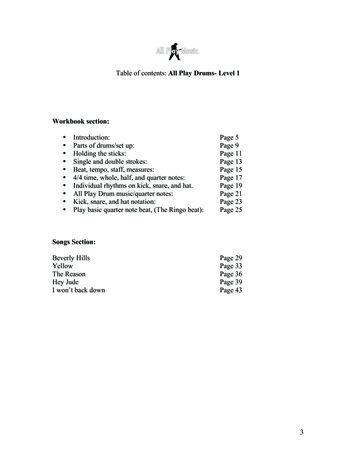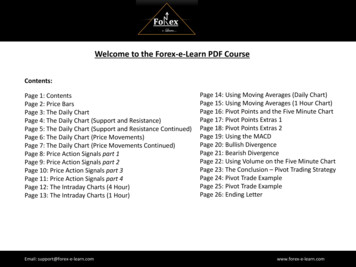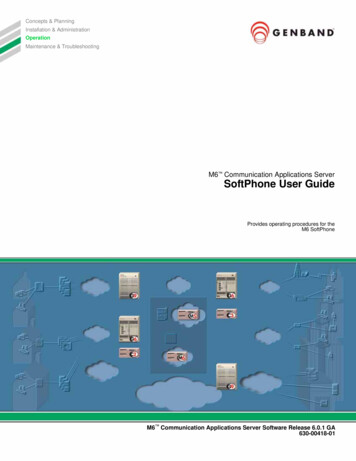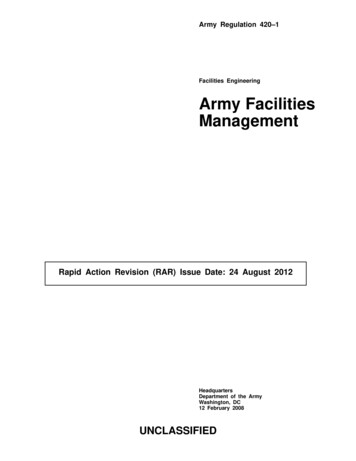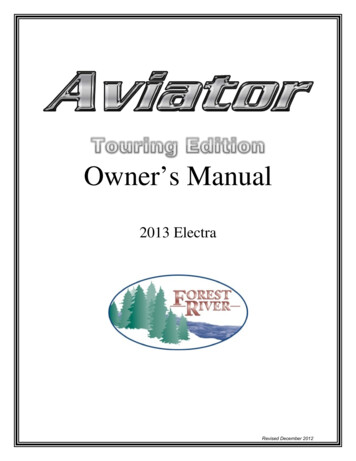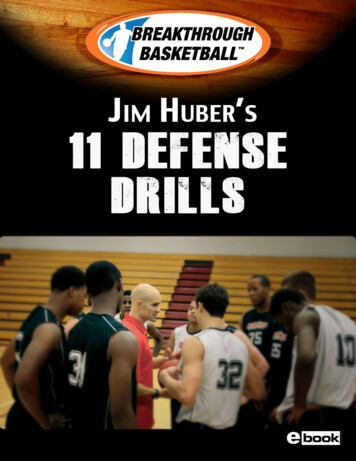
Transcription
P a g e 2IntroductionIn the following ebook, you will find eleven great defensive drills to build a better defense fromcoach Jim Huber. 11 Defensive DrillsSpecial Bonus: Step By Step Outline For Developing Your DefenseIf you want to learn how to develop a man to man defense step by step from the ground up, checkout Jim Huber’s Man to Man Defense.The video and ebooks will give you the defense, details, and explanations that you need beforeteaching your huber-defense.html
P a g e 3About Jim HuberSome of Jim Huber’s credentials include: Over 20 years of basketball coaching experience at the youth, high school, and collegelevels. Coached a team to a 1st place finish at the 2013 Nike Global Challenge. Coached at the Nike Elite 100 Camp which selects the top 100 high school players. #1 Team Defense at 2013 Nike EYBL which has the top 40 Nike High School teams fromNorth America and consists of 18 regular season games. Qualified for 2013 Nike PeachJam. A head coach for Mokan Basketball. Mokan is a direct Nike sponsor program. In 2012 whenCoach Huber was Director of Basketball Operations, Mokan reached the Final Four at thePeach Jam, which only selects the top 24 teams from the Nike Elite Youth BasketballLeague (EYBL). 45 Championships, 13 Runner-up Finishes, and 26 Final Four Finishes at regional andnational tournaments since 2004. 42 Collegiate players and 22 at Division 1 level.
P a g e 41 On 1 Close OutIf you don’t have great defensive close outs, it doesn’t matter how great your help defense is whenyou are at a constant disadvantage, the offense is going to score a lot.And think about this, you can have anywhere between 100 to 250 close outs per game. Multiplythat over the course of a season, you might have 2,000 to 10,000 close outs per season!!Poor close outs can destroy your defense which will lead to the offense scoring more pointsagainst you. In order to have a great defense night in and night out, you must be able to defendthe basketball in a one on one setting.Purpose:This is a fast-paced drill to practice in order to get better at closing out, contest shots, and preventdribble penetration. It forces defenders to learn how to defend in a game-like environment. Thereis nothing better than improving on ball defense by putting the defensive player out on an islandand forcing the defender to stop the player one on one.Setup: Defense, X1 and X2 start under the basket. Each player has a basketball. The two offensive players are positioned on the wings.Instructions:X2 starts the drill with a pass to 2 on the wing.Defender X2 follows the pass with a hard closeout.The Defender’s job is keep the ball out of thehouse (paint area) and force a contested jumpshot, then block out and hunt the rebound.Progression 1: The offense is not allowed to go“live” until the defender closes out and givesthem a “touch” of the hand.After one repetition, you can go to the nextprogression.Progression 2: The offense goes “live”immediately on the catch.
P a g e 5Points of Emphasis: Sprint To Eliminate Offensive Advantage – Defensive players should sprint on the closeouts. The quicker you can contest a shot and immediately get into a balanced position toeliminate dribble penetration, the less of an advantage the offense will have. Hands Up – Depending on your preference, either have one hand or two hands up tocontest the shot and immediate entry passes from the offensive player. Position Appropriately – Whether you believe in getting the defender’s butt to the basketor forcing the offensive player in a particular direction, be sure to position yourselfappropriately. Bad positioning will create easy driving opportunities for the offense. Practice Good Offensive Habits – Make sure we emphasis the little things in every drill. Isthe offense coming forward to catch the pass? Or are we being lazy, standing still waitingon the pass? Just because the focus of a drill is defensive, don’t let little things slide withthe offensive players. If you let little things slide in practice, you’ll end up getting beat bylittle things in games.Variations:Loser Stays On Defense – If the offense scores, the defender must stay on defense until they geta stop. You can rotate the offensive player each repetition.Add Passer – So the defender doesn’t know when the pass is going to occur, you can have thecoach, manager, or other players pass. This will improve anticipatory skills and reaction speed forthe defender as it emulates what will happen during a game.Vary The Passing Position – You can also pass from different positions on the floor to close outfrom different angles and positions like you would during a game. You can also have coaches,managers, or other players act as passers.Time Clock / Limited Dribbling – You can also have dribble limits and time clocks, so the offensealso has to practice good offensive habits.Coaching Tips: Alternate Sides – Go side to side for efficiency. When one pair is running live, another pairshould be ready to go on the other side. Make Drills Competitive – Make the drills competitive by having players keep score.Create accountability.
P a g e 6Man In The HolePurpose:Even if you play half court or quarter court defense, this should be a staple for every coach. This isa great 1 on 1 transition drill that works on your ability to stay in front of a ball handler in the opencourt. You work on the shuffle, the quick turn, running, and the turn and sprint to recover.Additionally, it’s great for conditioning and building mental toughness.It not only improves your 1v1 full court defense, it improves overall athleticism and conditioning.When you have to shuffle, sprint, change directions over and over, you’re going to improveathleticism and reaction time.Even zone defense coaches use drills like these because of the tremendous benefits that theyproduce.Setup:The ball hander (2) has the ball on the baseline.The defender (X1) is standing in front of theoffensive player ready to play defense.Instructions:The offensive player (2) tries to beat thedefender (X1) down the floor.The defensive player tries to stop the ballhandler from advancing the ball.After the ball handler (2) makes it to the otherend, they will hand off to 4, who will be facingthe same defender X1, back up the courttowards player 3.3 is the last ball handler. X1 defends for thethird and final time.X1 is now “out of the hole” and you rotate to thenext defender. X1 is now the next ball handler.
P a g e 7Points of Emphasis: Stop The Ball – The number one goal is to stop the ball from advancing. Push Step & Sprint – The defensive player should push step (shuffle) and sprint to containthe ball handler. If the defender gets beat, they need to turn and sprint to a spot to cut offthe ball handler. Offense Practices Good Habits – The offense also needs to focus on good habits ofprotecting the ball and using effective change of pace and change of direction moves. Go Back To Where Defender Was Beat – If the offense gets by the defender, don’t letthem just turn and jog to the other baseline. Have the defender and offensive player goback to where they got beat. This will ensure focus and effort to stop the ball.Coaching Tips: Encourage Players – Encouragement and energy from the Coach can help keep a playergoing in a drill like this. Get involved and work with them! Split The Court – Be sure to split the court into alleys. You can set up three to four alleyson each court. This allows you to work the entire team with this drill. You can use cones orother lines on the court.
P a g e 81 On 1 To 3 On 3 Full CourtPurpose:Being able to defend the ball in a one on one situation is vital. However, you need to have thecapability to transition into help defense in a team setting!This drill is about building great 1on1 full court defense habits and transitioning into a half courtsetting. Then you work on all other aspects of your defense. Defending cuts, screens, getting intohelp position, stopping dribble penetration, etc. 3v3 defensive drills are also great because it’stougher to defend the entire court with three players than with five players like during a game.Additionally, the offense learns how to handle the ball under pressure and improve passing.Setup:You have the ball handler start on the baseline.You have the defender guarding them.Two offensive players and two defensiveplayers are set up on the opposite end of thefloor.Instructions:The defense’s goal is to get a stop. Their goalis to only allow one shot each possession. Theoffense’s goal is to score.The ball handler (2) advances the ball and triesto beat the defender (X2).Once the ball is dribbled past half court, it is a“live” 3 on 3 situation.After each possession, the defense turns tooffense. Then they check the ball on thebaseline and start over.
P a g e 9Points of Emphasis: Contain Ball – Your goal as a defender now is contain the ball. You do not allow straightline drives. You want to stay between your player and the basket! Wing Defenders Deny Pass – Defenders X3 and X4 are going to deny the pass on thewing and make it difficult to catch. Help And Recover – The defenders have to be ready to help and recover should the ballhandler get past the initial defender. Help Across Not Up – If the ball handler beats the initial defender, the other defender, X3,is going to have to find a way to help slow the ball to give the recovering teammate time toget back. They should help “across” from their own player and keep the ball and their playerin their line of sight. Try to stop the ball on the same level as your own player if possible.Helping “up” the court from your player in this situation will lead to the easy bucket on thelob ahead. Force Contested Jump Shots / No Lay Ups – Your Goal? Do not let the other teamscore! You do that by keeping the ball as far away from the basket as possible. Lay ups areNOT allowed! You want a contested jump shot as far from the basket as possible, with asmuch pressure and difficulty as possible.Variations:Force Turns Prior To Half Court – If you want to make the drill really challenging for the full courtdefender, you can reward them for the number of times that they force the ball handler to stop andchange directions. Each change of direction is worth one point. Once they reach half court, itgoes back to playing defense straight up.Also, this can be a similar strategy to use against teams that lack effective ball handlers or if youhave some superb 1 on 1 full court defenders.Defense Stops – One effective tactic to get players to focus on the defensive end is to only allowthem to transition to offense by getting a defensive stop. If they don’t get a stop, a new group ofdefenders comes in to stop the ball. If you score on offense, you stay on the court.Winner Stays – You can set up teams of three and play to a determined amount of points. Thewinners stay on the court.
P a g e 104 On 4 Shell DrillPurpose:The shell drill is a great tool for teaching your defense. From a big picture perspective, you canquickly teach your players exactly what your team defense should look like.You can practice all of your defensive concepts in a team situation. You work on ball defense,being in a great stance, closing out, jumping to the ball, sprinting areas, and other key defensiveconcepts.You can practice defending any situation. You can practice defending all types of cuts, screens,and offensive actions. You can practice defending basket cuts, backdoor cuts, flare cuts, downscreens, ball screens, back screen, staggered screens, horns sets, Princeton sets, etc.It’s also great because it allows you to be efficient with your team. You can have four or fivedefenders practicing defense all at once.You can also use the shell drill to work on specific defensive techniques. That way, if you’restruggling with a particular offensive action, you can break it down and make sure your playersunderstand how to defend in that situation. Also, you can get a bunch of reps in a short amount oftime to solidify their learning.The following is a beginner progression for teaching the shell drill. You can also see progressionsfor teaching how to defend down screens and back screens.Set Up:You position four or five offense players on the court.You position a defender guarding each offensive player.Instructions:Progression 1 – PositioningWhen you instruct, “Pass.” Offense passes theball. You look for correct help positioning,proper close outs, appropriate on-ball defense,and necessary effort.
P a g e 11Progression 2 – InterchangeThis is the same as progression 1, except nowyou have the players interchange positions fromcorner to wing when you instruct, “Interchange.”This is a great way to get players defendingmore positions and situations.Progression 3 – Baseline DriveNow you instruct, “Pass. Skip. Beat Them.Pass Out.”“Pass” indicates that you pass to the personnext to you.“Skip” indicates you pass to the player twopeople away from you.“Beat Them” means that you drive baseline toforce help. At first, the on-ball defender will letthe ball handler go to practice rotations.“Pass Out or Kick Out” means that after thebaseline drive, the ball handler turns andpasses the ball back out to a perimeter player.Progression 4 – LiveYou take the defense through the samebaseline drive routine as progression 3.You now instruct, “Live!” This means that theoffense and defense play basketball.Rotate defense to offense after a predeterminednumber of “stops” by the defense.The drill can also progress to allowing theoffense to rotate and have basket cutters.
P a g e 12Progression 5 – Down ScreensThe drill is set up with 4 offensive (black) and 4defensive players (numbers), with a coach uptop with the ball.The coach will start the drill by passing to one ofthe players at the elbow.The help side offensive players will set apredetermined screen.The defense will jump to the ball and work todefend the screen correctly.Once screens are consistently being defendedcorrectly, the drill can be moved to a “live”scenario.Progression 6 – Back ScreensThe drill is set up with 4 offensive players onthe outside and 4 defenders on the inside.Coach is up top with the ball.Coach starts the drill with a pass to the elbow.The offensive player on the weak side block willset a back screen for their teammate on theweak side elbow.Defender X4 will hang back and become“goalie” and defend the lob, seeing cutter andthe ball (yellow areas).Once the player who was back screened getsthrough and recovers, the “goalie” can close outon their player.
P a g e 13Points of Emphasis Jump To The Ball – Make sure we are anticipating the pass and jumping with ball, notreacting to the pass being caught. Move with the ball like you have a magnet in your chest. No Layups – Seal the seams and force the ball outside the scoring area, the area that weconsider our “house”. Don’t Hug Your Player – Don’t hug your player when they are going to set a screen. If youhug the player, play too closely, the screener might be able to set a “double” screen andscreen you and a teammate at the same time. Stay up the line, on the line from the ball andgive the player being screened enough room to get through. Ball Side Of Down Screen – Jim teaches the defenders to go “ball side” of the screen, sowe are coming up the middle in a help position. In the bottom diagram, X3 would fight to getaround the screen on the ball side where the offense, 1 in black, has received the ball. No Lobs – Non Negotiable on Defense – We do not allow LOBS on back screens. Get Skinny On Screens – When your player calls out the screen, get “skinny”. Turn at anangle that makes you more difficult to screen and be ready to move. If you get caught “fatand flat” by that back screen, you are going to have a difficult time recovering and gettinground the screen.Coaching Tips Demand Great Effort – Be sure they sprint to areas and give maximum effort. Oftenplayers think they are giving maximum effort, but they are not. Immediately correct and repout until the player does this correctly. Playing with great effort can help you overcome a lotof mistakes. Master The Basics / Don’t Rush – When it comes to youth and high school basketball,don’t worry about progressing until you master the basics of positioning, help defense,communication, and effort. If you do these things, it can counter many things that theoffense throws at you.
P a g e 144 On 3 Overload DrillPurpose:In the game of basketball, there are many situations where you have to scramble and match upwith players; like rotating out of help defense and in transition. This is one of the best drills toimprove your ability to scramble and match up.Your defense is at a constant disadvantage and it forces them to hustle, communicate, and rotate.In this 4 on 3 situation, someone will always be open, but with good positioning and effort you cankeep things under control. This drill can also be done as a 5 on 4 type of drill.Set Up:You start with three defenders and fouroffensive players.The ball starts on the wing.Instructions:As the ball is passed, defenders have to leavetheir player, scramble to cover the ball or be in agood help position.The ball can be skipped and players are allowedto dribble penetrate in their areas (but aremostly stationary early on as you learn rotation).After you get the hang of rotating andscrambling, you go “live” and the offense looksto score.
P a g e 15Points of Emphasis: Effective Close Outs – If you are not going all out on our close outs in this drill, you will beexposed pretty quickly. You are already down in numbers, if someone isn’t closing all outand under control, you are beaten before you even start. Sprint To Areas / Effort – Hold people accountable on effort. Make sure they are sprintingto areas.Coaching Tips Progress To More Situations and Increase Difficulty – After you are satisfied with theconcepts sinking in, you can allow the offense free movement, interchanges, screens etc.
P a g e 16No Paint DrillPurpose:This is one of the best drills at eliminating penetration into the paint! It really develops a mentalityof protecting the paint and not letting anybody get in there.If you believe that penetrating via the pass or the dribble is one of the best offensive weapons, thisdrill is a must!It’s also a great all around defensive drill for practicing proper defensive habits.Set Up:You have four offensive players.You have four defensive players matched upwith the defensive players.A coach or manager is positioned at the top.Instructions:Coach starts drill with a pass from the top. Theobject of the game is to keep the ball frompenetrating the paint (lane).You can put tape on the floor to extend the lane.Offense gets a point for penetrating the paint onthe dribble drive or pass.You can change possession on points scored(in the paint), turnovers, and defensiverebounds. It's just a like a regular half courtgame, except the only way to a point is to the inthe lane.The first team to 3 wins. Playing to a lownumber (like 3) makes it really competitive andkeeps the intensity at the level you want.
P a g e 17Variations:3-Point Shot Hits Rim – A progression would be to add that the offense can score another pointby taking a three point shot that hits the rim. This forces defenders to maintain intense ballpressure.Excessive Fouling – You want our players playing hard on defense, but playing smart. Foulingand putting people on the free throw line is unacceptable. It’s not playing smart. The nextprogression in the drill is to begin awarding points if you are seeing excessive fouling and handchecking to stop the penetration. Make them stop the ball with their feet moving, not their handsreaching.
P a g e 185 On 5 Whistle ChangePurpose:This drill works on your defenders’ ability to scramble and pick up a different player when a gamesituation forces them to do so. This often happens in transition and rotating out of help defense.Communication is a must in this drill and your players will be forced to improve.Set Up:You start with five offensive players and fivedefensive players.They are matched up five on five.Instructions:You start playing five on five live.On the whistle, the offense will set the ball downon the ground.Someone on defense (anyone but the playerwho was guarding the ball), has to pick the ballup. X2 is picking it up in the diagram.When the X2 picks the ball up X2’s team is onoffense.The team that sets the ball down (in black) mustscramble to guard someone. They cannot pickup the player that was guarding them. Example,1 in black could not pick up X1.Points of Emphasis: Communicate! – Players must communicate in this drill. If they don’t, they will fail.Forcing players to talk and think on their feet as they scramble is making practice harderthan what they will likely face in a game situation. Anytime you can do that in a drill, yourteam stands to benefit in the game.Stop the Ball – Even though players are matching up in the drill, they must be aware of theball handler. The ultimate goal is to stop the offense from scoring, so help defense must bealert and stop the ball when necessary.
P a g e 19Variations:Full Court – You can also play the game full court as a variation. You don’t even have to start in ahalf court setting. Make sure to keep the team’s baskets the same, though.Coaching Tips: Variety – Make sure to vary who has possession of the ball and the location of the ballwhen blowing the whistle. Keep Coaching Defense – Keep coaching proper defensive fundamentals throughout thedrill. Make sure that they close out properly, maintaining good position, rotate on help,defend screens properly, etc.
P a g e 204 On 4 With Baseline DriversPurpose:This drill is great for improving your team defense. Specifically, it improves your communicationand your team’s ability to help and recover on dribble penetration. Your players have to give 100%effort and focus in order to succeed in the drill.This is a classic example of making practice more difficult than the games. If you can stop theopponent when you’re playing 6 on 4, you know that you can stop them playing 5 on 5. Since yousucceed this during practice, you will have the confidence to lock down the opponents duringgames.Set Up:There are four offensive players and fourdefensive players.Additionally, there are two designated baselinedrivers (BD) who are positioned in the corners.They are not actively guarded.The baseline drivers can be coaches,managers, or players.Instructions:You start the drill. The four offensive players tryto score and the four defensive players try tostop them.The baseline driver can choose to drive or passthe ball immediately. If the baseline drivercatches and holds the ball, no help is needed. Ifthe baseline driver dribbles to the basket, thedefense must stop the ball, communicate, androtate.As your players begin to understand therotations and are scrambling well, you can allowthe offense to dribble penetrate, dointerchanges, etc. This will make the drill muchmore challenging.
P a g e 21Points of Emphasis: See Your Player and the Ball – You must see your player and the ball at all times. If youtake your eye off either one, it can result in an easy scoring opportunity for the offense. Help Early & Quick – You must sprint to spots and immediately move once you see theplayers dribble drive to the basket. If you wait for a split second, it’s too late.Coaching Tips: Teach When NOT To Help – If one of the guarded players attack the basket, teach yourplayers when they should and should not help. Some coaches teach to help the playerwhen they have a straight line advantage to the goal. If the defensive player is positionedbetween the player and the basket, don’t help. If the offensive player is not driving directlyto the basket, don’t help. Mix Up Drive & Pass – Encourage the baseline driver to mix up between shooting andpassing. This will make it more game-like and keep the defense alert and challenge themmore.
P a g e 225 On 2 Weak Side HelpPurpose:This defensive drill improves your defensive positioning, your ability to defend flash cutters, andcommunication on interchanges. It’s a great way to isolate two defensive players and take themthrough a variety of situations.Also, sometimes it can be difficult to see everything when you have four or five players on the floor.This is especially true for new coaches and even seasoned vets can’t see everything. This is agreat way to isolate your players, so you can see precisely what they’re doing and enforce gooddefensive habits.Set Up:There are five offensive players on theperimeter.There are two defenders that are matched upman to man. X1 is guarding 2 and X2 isguarding 3.Instructions:When the ball is passed to the wing, you arejumping to the ball. X1 is applying ball pressureand X2 is ready to help seal the seam on thedribble drive (bottom diagram).The ball can be skipped across, in which casethe defenders would be jumping with the ballinto a help position on the midline, head onswivel, looking for flash cutters.After the skip, the offensive players may flashcut the lane and look for the ball.The offensive players (2 and 3 in black) areallowed to interchange as well.
P a g e 23Points of Emphasis: Constant Communication – The two defenders should be in constant communication.That way, they know how to help, recover, and rotate properly. You don’t want two playersguarding the ball. Sprint to Areas! Anything less than 100 percent is unacceptable. Get in the habit of goingall out in sprinting to where you need to be. Move with the Pass, Not on the Catch – Be anticipatory in movement. Move with the ballas though a magnet was in your chest.
P a g e 24Complete Man To Man DrillPurpose:This defensive drill is superb for transitioning between the different positions on the floor to defendmany situations. You transition from 1 pass off the ball, 2 passes off the ball positioning, defendingthe post, defending flash cutters, closing out, and helping on dribble penetration.Also, as a defender, you can’t hide in this drill. You are out on an island and you must fullyunderstand where you should be positioned at all times.Set Up:A coach, manager, or player is positioned at the top of the key.A defender (X1) is guarding a player on the wing (2).Instructions:Coach starts up top with the ball. Defense X1 isin 1 pass away position on the line, up the line.Coach will dribble to the wing and the offensiveplayer 2 will rotate into the post. X1 will takethem on in a ¾ front in the post.Offense 2 will vacate the post and move theweak side wing. X1 should be in a 2 pass awayhelp position with ball on the opposite wing withCoach.Offense will flash cut, defense will pick them upand try to force them up the lane to catch awayfrom the paint.If the offense goes back door on the cut, weswivel and pick them up, hand in the passinglane.Once the offense catches the ball, you are liveone on one.
P a g e 25Points of Emphasis: Up the Line, On the Line – Up the line, on the line means forming a flat triangle, halving itbetween ball and the player they are guarding. Have a hand on the imaginary stringbetween the ball and your player. Not past the string, ON it. Past it will get you beat backdoor, as your body will be too high and out of position. See Player & Ball – When positioned, you should always have your eye on the player withthe ball and the player you are guarding. You have to be aware of the ball, so you canposition yourself properly to help on defense. You also need to be in the right position, soyou can defend your player if a pass is received. If you just watch the ball, it’s easy for yourdefender to cut to an open spot on the floor for a scoring opportunity. Step In Front Of Cutter – Don’t let the flash cutter receive the pass. Be sure to cut themoff. You don’t want any penetrating passes within the 3-point arc.Variations:Mix Up Cuts & Positions – You can also tell the offensive player to randomly give the defensiveplayer different looks. This is a good progression because it is more game-like as the defenderhas to react similar to a game rather than just learn the sequence. You might tell the offensiveplayer to choose three or four different cuts and positions at random.Coaching Tips: Fake Dribble Penetration – Make sure that the person with the ball fakes dribblepenetration periodically throughout the drill. This ensures that the defender is watching theball and the player they are guarding at the same time. Don’t Depend On Drill – You shouldn’t depend on this drill as a way to defend. The realtest is when you are defending with other players on the court. However, it is a goodvariation to use in practice to initially learn defensive habits. You can also use it as avariation to quickly review defensive principles.
P a g e 262 On 2 Ball ScreensPurpose:When it comes to the on ball defender and the defender guarding the screener, this is one of thebest ball screen drills that you can use. Why? The defenders don’t have any help defense! Thismakes it way more challenging than during the game. If they can adapt and have success in thissituation, your team defense will be that much stronger.Set Up:There are two offensive players and twodefensive players. You are playing 2 on 2. Ifdesired, you can also play 3 on 3.In this diagram, the player with the ball starts atthe top of the key. However, you can start fromthe wing as well.Instructions:The first action at the start of every possessionis a ball screen. In this scenario, 2 sets a ballscreen.Defender X2 is calling out the screen andjumping to the high side to “hedge” the ballhandler east-west.Defender X1 is trying to fight over the top of thescreen, and only going underneath if they arecaught up in the screen.Next progression is “dribble handoff”. You“switch” on a
The Defender’s job is keep the ball out of the house (paint area) and force a contested jump shot, then block out and hunt the rebound. Progression 1: The offense is not allowed to go “live” until the defender closes out and gives them a “touch” of the hand.



